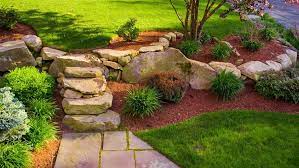5 Green Ways to Keep Your Landscaping Green
Green landscaping practices aim to reduce the use of fertilizers and pesticides by creating healthy soil with regular applications of compost and mulch.
Replace lawns with native plants better adapted to your region’s climate and soil conditions, which also tend to be more resistant to insects and diseases.
Watering your lawn first thing in the morning allows it to absorb its needed moisture before heat waves arrive. Mulching helps retain soil moisture and control weed growth.
Use Recycled Materials
Recycling materials in your landscaping design can both help the environment and save you money. There are various eco-friendly alternatives available on the market such as wood, concrete and asphalt that offer sustainable alternatives for traditional landscaping applications.
Many of these products are constructed from recycled materials like pallets, tires and garden hoses – using them in gardener landscaper your landscaping will add character and help reduce landfill waste.
One easy way to incorporate recycled material in your landscaping is by creating unique planters from recycled items found around your yard. Not only can creating these pieces be fun and gives your yard its own distinctive aesthetic; these planters may even protect plants from ground-dwelling animals or insects and offer added peace of mind and added protection for valuable investments like plants.
Reduce Your Water Use
No matter where you live or the style of yard you desire, conserving water usage in landscape is possible through multiple techniques that reduce its usage such as reducing irrigation frequency, using mulches or not overwatering your garden beds.
An effective strategy for conserving water is planting the right plants in their respective spots. A carefully considered planting plan takes into account each plant’s individual water requirements while taking into account how best they might blend into their environment.
Avoid overwatering and fertilizing. Fertilizers promote growth but may increase your water requirements, while mulch keeps soil cool, minimizes evaporation, and prevents weeds. Weeds steal vital resources from desirable plants; remove them promptly before they go to seed!
Harvest Your Rainwater
Rainwater collected from gutters is an abundant, free source of drinking water that doesn’t require filtering; typically free from dissolved minerals and chemicals; though you may need to regularly aerate it to avoid algae or surface scum growth.
Green landscaping entails selecting plants that don’t require much additional watering – this practice is known as xeriscaping and can be especially helpful in dry environments.
Do not discard grass clippings and yard waste without first creating compost piles to reuse as fertilizer for your lawn and garden. Compost can not only enrich soil health, but it can also insulate it to conserve moisture levels in your area and keep patios and retaining walls cooler during hotter climates. In addition, consider busted concrete found at construction sites for patios or retaining walls as it makes an economical alternative to flagstone pavers and often costs less.
Plant Native Plants
Native plants offer wildlife an ideal home and add beauty to any landscape. By encouraging biodiversity, they help offset fossil fuel use and sequester carbon. Furthermore, their food source feeds birds, insects, and other beneficial wildlife in return.
Native grasses, flowers, and shrubs tend to thrive in your region’s climate and soil types; often needing less water, fertilizers, or pesticides than their exotic counterparts.
Native plants can be purchased at various garden centers and mail-order catalogs. When selecting native flowers with varied blooming seasons and fall-blooming berries that make an impressionful statement in fall. Invasive species should also be avoided to ensure wildlife thrives in your yard year round. Be wary of invasive varieties which overrun native species. Invasive varieties often overwhelm local ecosystems by outcompeting other plants for space or food source and prevent wildlife from using an area as shelter or food source.
Reuse Materials
Reusing materials helps reduce landfill waste. Repurposing bricks or stones add charm and beauty while saving on new material costs; while selecting salvaged wood for walkways and patios provides aesthetics while providing added peace of mind regarding safety concerns.
Mulching grass clippings, leaves and other organic debris onsite helps conserve water and nutrients while producing natural fertilizer. Watering less frequently allows grass to go into dormancy and inhibits weed growth.
Reusing wood from railroad ties, bricks or other materials to craft distinctive garden containers is an effective way to both recycle and personalize your green space. The result will be an attractive garden that stands out from the competition.




